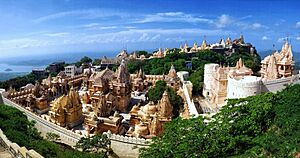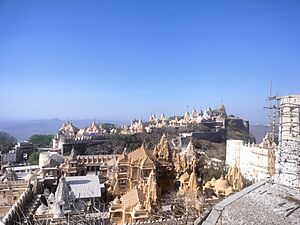Palitana facts for kids
Quick facts for kids
Palitana
|
|
|---|---|
|
Town
|
|

View of Palitana
|
|
| Country | |
| State | Gujarat |
| District | Bhavnagar |
| Named for | Padliptpuram |
| Government | |
| • Type | Municipal |
| • Body | Palitana municipal corporation |
| Area | |
| • Total | 83.2 km2 (32.1 sq mi) |
| Elevation | 66 m (217 ft) |
| Population
(2011)
|
|
| • Total | 64,497 |
| Demonym(s) | Palitani |
| Time zone | UTC+5:30 (IST) |
| STD code |
02848
|
| Vehicle registration | GJ-04(Bhavnagar) |
Palitana is a city in Gujarat, a state in India. It is located about 50 kilometers (31 miles) southwest of Bhavnagar city. Palitana is a very important place for people who follow Jainism. It is known as one of the first cities in the world to be completely vegetarian by law.
Contents
History of Palitana
Palitana has a long and interesting history, especially for Jains. It is believed that Ādinātha, the first Tirthankara (a spiritual teacher) in Jainism, meditated on the Shatrunjaya hill here. This is where the famous Palitana temples were later built.
The area that became Palitana State was started in 1194. Later, in 1656, a powerful merchant named Shantidas Jhaveri was given the village of Palitana. This was done by Murad Baksh, who was the Governor of Gujarat at that time.
The temples on the hill have been managed by a group called the Anandji Kalyanji Trust since 1730. Palitana was once a small kingdom under British rule in India. It became part of independent India in 1948.
Geography and Location
Palitana is located at coordinates 21.52°N and 71.83°E. It sits at an average height of 67 meters (219 feet) above sea level. The city also has the Palitana dam, which helps with irrigation. This dam is built on the Shetrunji River.
The Famous Palitana Temples
Palitana is home to the world's largest group of temples on a mountain. There are more than 900 temples on the Shatrunjaya hills. The entire mountain and its temples are considered the most sacred pilgrimage site for Jains.
Building the Temples
These amazing temples were built over 900 years, starting from the 11th century. They are made of marble and have very detailed carvings. The main temple at the top of the hill is dedicated to Rishabhanatha, the first Tirthankara. The Anandji Kalyanji Trust manages these temples.
Climbing the Sacred Hill
To reach the temples, you need to climb about 3,800 stone steps. The climb from the bottom to the top takes about an hour and a half. If someone finds it hard to climb, they can use special sling-chairs.
Jains have strict rules for climbing the hill. You cannot eat or carry food while going up. Also, everyone must start their journey down before evening. This is because no one is allowed to stay on the sacred mountain overnight.
Temple Architecture
The temples are beautifully carved in marble. From a distance, they look like tiny ivory models. The most important temple is for Shri Adishwar. It has fancy designs. Other important temples include those of Kumarpal, Vimalshah, and Sampriti Raja. The earliest temples were likely built by Kumarpal Solanki, who was a great supporter of Jainism. Some temples also hold valuable jewels, which can be seen with special permission.
Palitana: A Vegetarian City
In 2014, Palitana made history by becoming the first city in the world to be legally vegetarian. This means it is against the law to buy or sell meat, fish, or eggs in the city. It also means that jobs related to these activities, like fishing or keeping animals for food, are not allowed. This rule shows the strong commitment to non-violence in the city.
Population and People
As of 2011, Palitana had a population of about 64,497 people. About 52% of the population were males and 48% were females. The city has a good literacy rate of 74%, which is higher than the average for India. This means many people in Palitana can read and write.
Most of the people in Palitana, about 91.77%, follow Hinduism. Other religious groups make up the rest of the population.
Getting to Palitana
By Air
The closest airport is in Bhavnagar, which is about 51 kilometers (31 miles) away. This airport has daily flights to cities like Mumbai, Surat, and Ahmedabad. Ahmedabad, which is 215 kilometers (134 miles) away by road, has an international airport with flights to many major cities. The government is also planning to build a new airport in Palitana to help religious and tourist travelers.
By Rail
Palitana has a small railway station called Palitana railway station. It connects to Sihor and Bhavnagar. Most trains stop at Sihor, which has connections to Ahmedabad and Gandhinagar.
By Road
Buses run every hour from Palitana to Bhavnagar. There are also regular buses to Ahmedabad, Talaja, Una, and Diu. The roads are in good condition, so a trip to Una or Diu takes about 6 hours. Taxis can also be hired from Bhavnagar, Ahmedabad, or Vadodra to Palitana. The bus station is about 800 meters (half a mile) from the railway station.
See also
 In Spanish: Palitana para niños
In Spanish: Palitana para niños




